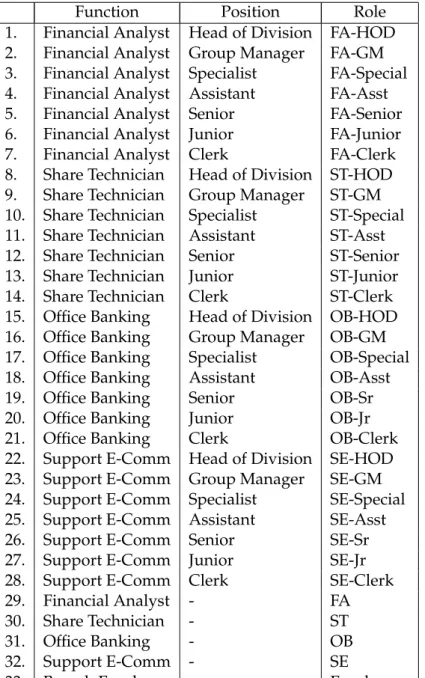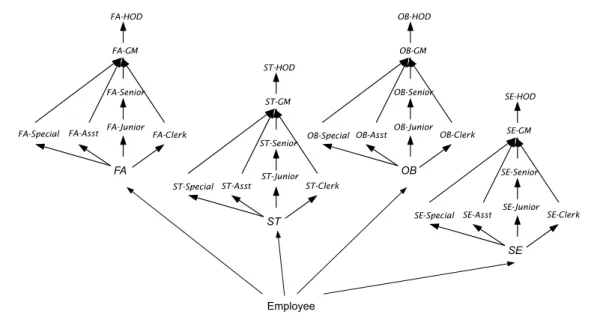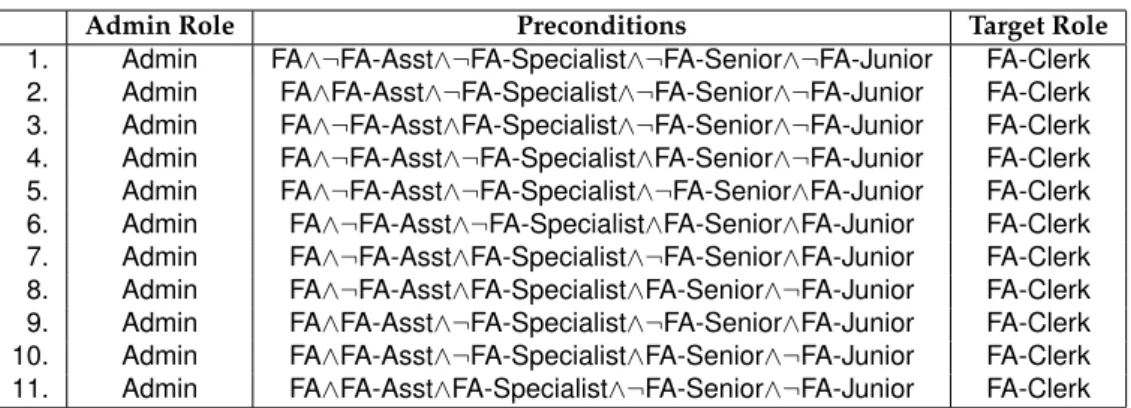Computer Science and Artificial Intelligence Laboratory
Technical Report
MIT-CSAIL-TR-2011-026
April 27, 2011
ARBAC Policy for a Large Multi-National Bank
Karthick Jayaraman, Vijay Ganesh, Mahesh
ARBAC Policy for a Large Multi-National Bank
Karthick Jayaraman Syracuse University kjayaram@syr.edu Vijay Ganesh MIT vganesh@csail.mit.edu Mahesh Tripunitara University of Waterloo tripunit@uwaterloo.ca Martin C. Rinard MIT mrinard@csail.mit.edu Steve J. Chapin Syracuse University chapin@syr.edu April 26, 2011 AbstractAdministrative role-based access control (ARBAC) is the first comprehensive administra-tive model proposed for role-based access control (RBAC). ARBAC has several features for designing highly expressive policies, but current work has not highlighted the utility of these expressive policies. In this report, we present a case study of designing an ARBAC policy for a bank comprising 18 branches. Using this case study we provide an assessment about the features of ARBAC that are likely to be used in realistic policies.
1 Introduction
This case study describes the design of an administrative role-based access-control (ARBAC) pol-icy for a bank comprising 18 branches. We designed the ARBAC polpol-icy to meet the following two goals:
1. Facilitate the business functions in each branch by appropriately provisioning roles to facil-itate the tasks of each job position.
2. Enforce a separation of privilege (SOP) property to prevent collusive behavior in the execu-tion of important job tasks.
The business functions and job roles used in each bank branch are based on an existing study. Schadd et al. [3] describes a role-based access-control (RBAC) policy for an European bank branch. We extend this policy into an ARBAC policy in two steps. First, we add 17 additional branches with the same functions and job roles. This is because we limited our case study to 18 branches, which is approximately 600 roles based on the number of roles in each branch. Second, we de-signed can assign and can revoke rules for administering role assignment actions such that the SOP property is enforced.
SOP is a key concern for financial institutions because they are required to enforce such prop-erties either by regulators or to be compliant with standards such as ISO 9000 [2]. SOP has its primary objective in the prevention of fraud or collusive behavior in crucial operations. Typically, SOP is enforced by dividing tasks and privileges for executing an operation among multiple users, and making sure that a single user cannot obtain all the privileges necessary for independently completing an operation.
For example, let us consider that the Widget corporation wants to enforce a high level of trans-parency in the processing of purchase orders. To meet this objective, Widget splits the purchase order transaction into two tasks, namely creation and approval. The permissions for the tasks are assigned such that junior level employees have the ability to create purchase orders, but only the division’s manager can approve the purchase orders. Formally, the SOP constraint for this exam-ple can be stated as, h { Creation, Approval}, 1 i, which means that a user can at most have one role from the set { Creation, Approval}.
This case study illustrates how SOP constraints can be enforced by using a well designed ARBAC policy. Three features of ARBAC, namely disjunctions, positive preconditions, and mixed roles, are useful in expressing the SOP constraints. This case study illustrates how these features are used in the policy. These features are complexity sources with respect to analyzing these policies for safety. Therefore, use of these features makes the automatic analysis of ARBAC policies harder. However, because of the utility of these features in enforcing properties such as SOP, we envision that realistic policies will take advantage of these features.
This case study also describes how to formulate safety queries for verifying properties of the policy. Formally, a safety query is a tuple of the form h u, r i that questions whether a user u can be assigned to a role r. Several questions about the policy can be formulated as one or more safety queries [1, 4]. We illustrate this with examples of safety queries for verifying the SOP property. Model checkers could be used for verifying these safety questions prior to deploying the policy.
The remainder of this case study is structured as follows. Section 2 describes the roles and the role hierarchy in the policy. Section 3 describes the design of the can assign and can revoke rules. Section 4 describes how to formulate analysis questions. Section 5 provides a summary.
2 Roles and Role Hierarchy
The bank comprises 18 branches. Each branch in the bank has 33 roles that are spread over four business divisions, namely financial analyst (FA), share technician (ST), office banking (OB), and support e-commerce (SE). Table 1 contains the list of roles in each branch and Figure 1 contains the role hierarchy. There are eight roles per business division, comprising the following:
1. A role for each business division from which all the other roles in the business division inherit. For example, all the roles in the FA business division inherit from the FA role. 2. Two managerial roles. For example, FA-HOD and FA-GM are managerial roles in the FA
division.
3. Five non-managerial roles. For example, FA-Asst, FA-Specialist, FA-Senior, FA-Junior, and FA-Clerk are non-managerial positions in the FA division.
Each branch has a role called employee, from which all other branch-specific roles inherit. Each branch has the same set of roles, leading to 594 roles in the bank policy comprising 18 branches.
In each branch, the five non-managerial roles in each business division have a separation of privilege constraint such that a user may not be assigned to more than 3 roles of the five roles. For example, FA-Asst, FA-Specialist, FA-Senior, FA-Junior, and FA Clerk are the five junior roles in the FA division. A user who is already assigned to one of these roles can be additionally assigned to at most 2 roles out of the remainder four roles.
Our policy assumes separate administration, which implies that administrative roles are not managed by the same set of rules that apply to the regular roles. We have a single role named
Ad-Function Position Role 1. Financial Analyst Head of Division FA-HOD 2. Financial Analyst Group Manager FA-GM 3. Financial Analyst Specialist FA-Special 4. Financial Analyst Assistant FA-Asst 5. Financial Analyst Senior FA-Senior 6. Financial Analyst Junior FA-Junior 7. Financial Analyst Clerk FA-Clerk 8. Share Technician Head of Division ST-HOD 9. Share Technician Group Manager ST-GM 10. Share Technician Specialist ST-Special 11. Share Technician Assistant ST-Asst 12. Share Technician Senior ST-Senior 13. Share Technician Junior ST-Junior 14. Share Technician Clerk ST-Clerk 15. Office Banking Head of Division OB-HOD 16. Office Banking Group Manager OB-GM 17. Office Banking Specialist OB-Special 18. Office Banking Assistant OB-Asst 19. Office Banking Senior OB-Sr 20. Office Banking Junior OB-Jr 21. Office Banking Clerk OB-Clerk 22. Support E-Comm Head of Division SE-HOD 23. Support E-Comm Group Manager SE-GM 24. Support E-Comm Specialist SE-Special 25. Support E-Comm Assistant SE-Asst 26. Support E-Comm Senior SE-Sr 27. Support E-Comm Junior SE-Jr 28. Support E-Comm Clerk SE-Clerk 29. Financial Analyst - FA 30. Share Technician - ST 31. Office Banking - OB 32. Support E-Comm - SE
33. Branch Employee - Employee Table 1: Roles Derived from Function and Official Positions
SE-HOD SE-GM SE-Special SE-Asst SE-Senior SE-Junior SE-Clerk SE Employee OB-HOD OB-GM OB-Special OB-Asst OB-Senior OB-Junior OB-Clerk OB ST-HOD ST-GM ST-Special ST-Asst ST-Senior ST-Junior ST-Clerk ST FA-HOD FA-GM FA-Special FA-Asst FA-Senior FA-Junior FA-Clerk FA
Figure 1: Role Hierarchy Design
min used for administering role assignments and revocations. Therefore, the Admin role appears as a precondition in all the assignment and revocation rules.
3 Can Assign and Can Revoke Rules
We designed can assign rules to enforce the constraint that a user can be assigned to at most 3 roles out of the five non-managerial roles in each business division. This constraint can be stated formally as,
h {FA-Asst, FA-Specialist, FA-Senior, FA-Junior, FA Clerk}, 3 i
The can assign rules are designed to express the valid conditions for assigning a user to a par-ticular role. The conditions specify the role memberships that are required for user to be assigned to a role. To meet our SOP objective, we need to enumerate all the valid conditions that can en-title a user to be assigned to each of the five non-managerial role. These conditions can then be expressed as one or more can assign rules.
We illustrate the design of the can assign rules using an example. For example, let us consider the FA-Clerk role. Table 2 contains the can assign rules for the role FA-Clerk. A user can be assigned to the role FA-Clerk, under three cases:
1. Case 1: If a user is is not assigned to any other managerial role, then he can be assigned to the FA-Clerk role. To express this condition, we created a can assign rule that contains FA as a positive precondition and four negative preconditions for the other four non-managerial roles.
2. Case 2: If a user is already assigned to a single non-managerial role, then the user may be assigned to an additional non-managerial role. To express this condition, we need four can assign rules. Each of these four rules will have 2 positive preconditions and 3 negative
Admin Role Preconditions Target Role
1. Admin FA∧¬FA-Asst∧¬FA-Specialist∧¬FA-Senior∧¬FA-Junior FA-Clerk 2. Admin FA∧FA-Asst∧¬FA-Specialist∧¬FA-Senior∧¬FA-Junior FA-Clerk 3. Admin FA∧¬FA-Asst∧FA-Specialist∧¬FA-Senior∧¬FA-Junior FA-Clerk 4. Admin FA∧¬FA-Asst∧¬FA-Specialist∧FA-Senior∧¬FA-Junior FA-Clerk 5. Admin FA∧¬FA-Asst∧¬FA-Specialist∧¬FA-Senior∧FA-Junior FA-Clerk 6. Admin FA∧¬FA-Asst∧¬FA-Specialist∧FA-Senior∧FA-Junior FA-Clerk 7. Admin FA∧¬FA-Asst∧FA-Specialist∧¬FA-Senior∧FA-Junior FA-Clerk 8. Admin FA∧¬FA-Asst∧FA-Specialist∧FA-Senior∧¬FA-Junior FA-Clerk 9. Admin FA∧FA-Asst∧¬FA-Specialist∧¬FA-Senior∧FA-Junior FA-Clerk 10. Admin FA∧FA-Asst∧¬FA-Specialist∧FA-Senior∧¬FA-Junior FA-Clerk 11. Admin FA∧FA-Asst∧FA-Specialist∧¬FA-Senior∧¬FA-Junior FA-Clerk
Table 2: Can Assign rules for FA-Clerk Roles
preconditions. Of the two positive preconditions, one is for a business division role FA and the other is one of the four non-managerial roles. The remainder non-managerial roles appear as negative preconditions.
3. Case 3: If a user is already assigned to two non-managerial roles, then the user can be as-signed to an additional non-managerial role. To express this condition, we need six can assign rules. Each of the six rules have 3 positive preconditions and 2 negative preconditions. The 3 positive preconditions include the business division role and two of the four non-managerial roles. The remainder non-managerial roles appear as negative preconditions.
As illustrated by Table 2, the can assign rules make use of disjunctions, positive preconditions, and mixed roles. The valid conditions for assigning the FA-Clerk role is essentially a disjunc-tion, in which each can assign rule is a disjunct. Also, several of the can assign rules have mixed preconditions because they have both positive and negative preconditions.
We followed the same procedure for designing the can assign rules for all the other non-managerial roles. The complete list of the can assign and can revoke rules can be obtained from our policy file1.
The can assign rules for the managerial roles were designed to enforce that a user assigned to any of the non-managerial roles cannot be assigned to a managerial role. Therefore, assignment rules for the managerial roles had negative preconditions for all the non-managerial roles and one positive precondition for the business division role.
In our policy, all the roles are revocable. Therefore, we had 594 can revoke rules, one for each role. We did not see any reason to make a branch-specific role irrevocable.
4 Analysis Questions
As mentioned earlier, several questions about the policy can be expressed as a safety query. We illustrate how the following two analysis questions can be expressed as a safety query:
1. Can a user be assigned to four non-managerial roles in a business division in any of the 18 branches?
2. Can a user be assigned to four non-managerial roles in a business division in all the 18 branches?
Both these questions can be encoded as a safety question of the form hu, targetrolei as follows. To express these analysis questions as safety queries, we need to add some additional roles, can assign, and can revoke roles. These additions do not affect the valid administrative actions for the other roles described in the policy.
For each branch, we add two additional roles, i.e., we add roles AnyFouriand Helperifor each
branch. The objective of the AnyFouriis to identify if a user can be assigned to four non-managerial
roles. We add can assign rules for this role in each branch to express the condition that if a user is a member of four non-managerial roles, then he may be assigned to this special role. The Helperi
roles help in the encoding of both safety questions. The can assign rules for each of the helper roles express the condition that if a user can be assigned to either AnyFouri or Helper(i+1), then he may
be assigned to Helperi.
To express question (1) as a safety question, we add a single can assign rule for targetrole that is of the form hAdmin, branch1, targetrolei. The consequence of this rule is that If a user can be
assigned to targetrole, then it implies that a user can be assigned to four non-managerial roles in at least one of the 18 branches.
To express question (2) as a safety question, we add a single can assign rule for targetrole that is of the form hAdmin, branch1∧ .. ∧ branc18, targetrolei. The consequence of this rule is that if a use
can be assigned to targetrole, then it implies that a user can be assigned to four non-managerial roles in all the branches.
5 Summary
We illustrated the design of an ARBAC policy with the intent of enforcing separation of privilege for a bank comprising 18 branches. The separation of privilege constraint that we have used is emblematic of realistic concerns. Disjunctions, positive preconditions, and mixed roles are very useful for encoding SOP constraints. The SOP constraints can be verified by designing safety queries.
References
[1] S. Jha, N. Li, M. Tripunitara, Q. Wang, and W. Winsborough. Towards formal verification of role-based access control policies. IEEE Trans. Dependable Secur. Comput., 5(4):242–255, 2008. [2] J. D. Moffett. Control principles and role hierarchies. In RBAC ’98: Proceedings of the third ACM
workshop on Role-based access control, pages 63–69, New York, NY, USA, 1998. ACM.
[3] A. Schaad, J. Moffett, and J. Jacob. The role-based access control system of a european bank: a case study and discussion. In SACMAT ’01: Proceedings of the sixth ACM symposium on Access control models and technologies, pages 3–9, New York, NY, USA, 2001. ACM.
[4] S. D. Stoller, P. Yang, C. R. Ramakrishnan, and M. I. Gofman. Efficient policy analysis for administrative role based access control. In CCS ’07: Proceedings of the 14th ACM conference on Computer and communications security, pages 445–455, New York, NY, USA, 2007. ACM.


